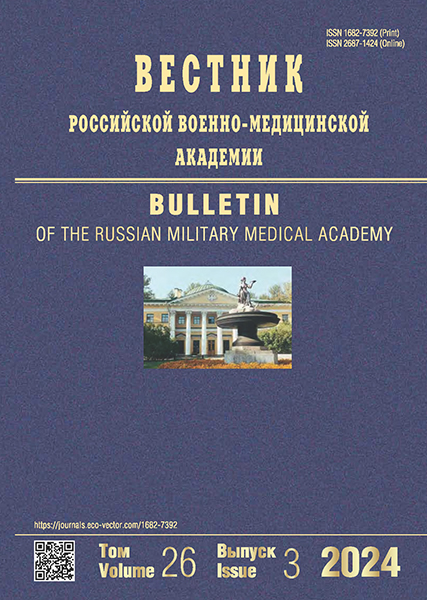脊髓尾部肿瘤手术治疗结果中盆腔器官功能的保留:术中神经电生理监测的作用
- 作者: Malyshok D.Е.1, Bisaga G.N.1, Оrlov А.Y.1, Aleksandrov M.V.1,2
-
隶属关系:
- Almazov National Medical Research Centre
- Kirov Military Medical Academy
- 期: 卷 26, 编号 3 (2024)
- 页面: 381-390
- 栏目: Original Study Article
- ##submission.dateSubmitted##: 21.12.2023
- ##submission.dateAccepted##: 06.06.2024
- ##submission.datePublished##: 06.09.2024
- URL: https://journals.eco-vector.com/1682-7392/article/view/624855
- DOI: https://doi.org/10.17816/brmma624855
- ID: 624855
如何引用文章
详细
本研究评估了在脊髓尾部肿瘤手术治疗期间对骨盆功能调节节段性器具状态进行术中神经电生理监测的有效性。这项研究是在99名Th11-S5椎体髓外和髓内脊髓肿瘤患者的神经外科治疗过程中进行的。根据术中神经电生理监测的范围,患者被分为两组。第一组对锥体系统进行标准监测;第二组对盆腔器官功能进行扩展监测,监测方法以球海绵体反射为基础。所有患者均在手术前和术后早期(10-14 天)进行了神经系统检查。术后12个月,对患者进行电话问卷调查,重点关注盆腔器官功能障碍的主诉。在每组患者总数中,有25%-30%的患者在术前发现盆腔器官功能障碍。术后10-14天内,第一组有20名(48.8%)患者出现盆腔器官功能障碍,第二组有16名(27.6%)患者出现盆腔器官功能障碍。手术12个月后,第一组的违规病例增加到23例(56.1%),第二组增加到17 例(29.3%)。缺乏监测会使术后早期盆腔器官功能障碍的风险增加2.5倍(几率比:2.50 (1.07; 5.79)),一年后增加 3.08 倍 (几率比:3,08 (1,35; 7,11)): 3,08 (1,35; 7,11)). 进行盆腔功能监测可将术后早期首次发现盆腔器官功能障碍的风险降低 5.2 倍(几率比 0.192 (0.04; 0.80))。因此,术中持续监测骨盆功能调节节段装置的状态,是将脊髓尾段肿瘤病变患者术后骨盆功能紊乱风险降至最低的一个因素。使用骨盆监测可提高手术的功能耐受性,维持或改善患者的生活质量。
全文:
作者简介
Dar’ya Е. Malyshok
Almazov National Medical Research Centre
Email: dashadzhil@gmail.com
ORCID iD: 0000-0002-2322-6753
SPIN 代码: 2204-4271
functional diagnostics doctor
俄罗斯联邦, Saint PetersburgGennadiy N. Bisaga
Almazov National Medical Research Centre
Email: bisaga@yandex.ru
ORCID iD: 0000-0002-1848-8775
SPIN 代码: 9121-7071
MD, Dr. Sci. (Med.), professor
俄罗斯联邦, Saint PetersburgАndrei Yu. Оrlov
Almazov National Medical Research Centre
Email: orloff-andrei@mail.ru
ORCID iD: 0000-0001-6597-3733
SPIN 代码: 4018-1328
MD, Dr. Sci. (Med.)
俄罗斯联邦, Saint PetersburgMikhail V. Aleksandrov
Almazov National Medical Research Centre; Kirov Military Medical Academy
编辑信件的主要联系方式.
Email: vmeda-nio@mil.ru
ORCID iD: 0000-0002-9935-3249
SPIN 代码: 5452-8634
MD, Dr. Sci. (Med.), professor
俄罗斯联邦, Saint Petersburg; Saint Petersburg参考
- Samochernykh N, Sysoev K, Kim A, et al. C2 spinal nerve tumors in young adults: report of two cases and review of the literature. Child’s nervous system. Childs Nerv Syst. 2021;37(2):691–694. doi: 10.1007/s00381-020-04777-2
- Konovalov NA, Golanov AV, Shevelev IN, et al. The outcomes of treatment of cauda equina ependymomas in adults. Burdenko’s Journal of Neurosurgery. 2015;79(1):58–67. (In Russ.) EDN: TXLKPV doi: 10.17116/neiro201579158-67
- Wostrack M, Shiban E, Obermueller T, et al. Conus medullaris and cauda equina tumors: clinical presentation, prognosis, and outcome after surgical treatment: clinical article. J Neurosurg Spine. 2014;20(3):335–343. doi: 10.3171/2013.12.SPINE13668
- Deletis V, Vodusek D B. Intraoperative recording of the bulbocavernosus reflex. Neurosurgery. 1997;40(1):88–93. doi: 10.1097/00006123-199701000-00019
- Granata G, Padua L, Rossi F, et al. Electrophysiological study of the bulbocavernosus reflex: normative data. Funct Neurol. 2013;28(4):293. doi: 10.11138/FNeur/2013.28.4.293
- Sugiyama K, Harada N, Kondo K, et al. Relationship between preoperative neuroradiological findings and intraoperative bulbocavernosus reflex amplitude in patients with intradural extramedullary tumors. Neurol Med Chir (Tokyo). 2021;61(8): 484–491. doi: 10.2176/nmc.oa.2020-0425
- Malyshok DЕ, Bisaga GN, Оrlov АYu, et al. Effectiveness of intraoperative monitoring of the bulbocavernosus reflex for predicting postoperative pelvic disorders in the surgical treatment of distal spine tumors. Bulletin of the Russian Military Medical Academy. 2023;25(3):403–412. EDN: BGGFWY doi: 10.17816/brmma487910
- Shimada Y, Miyakoshi N, Kasukawa Y, et al. Clinical features of cauda equina tumors requiring surgical treatment. Tohoku J Exp Med. 2006;209(1):1–6. doi: 10.1620/tjem.209.1
- Han IH, Kuh SU, Chin DK, et al. Surgical treatment of primary spinal tumors in the conus medullaris. J Korean Neurosurg Soc. 2008;44(2):72–77. doi: 10.3340/jkns.2008.44.2.72
- Schwab JH, Healey JH, Rose P, et al. The surgical management of sacral chordomas. Spine (Phila Pa 1976). 2009;34(24):2700–2704. doi: 10.1097/BRS.0b013e3181bad11d
- Aleksandrov MV, Chikurov AA, Toporkova OA, et. al. Neurophysiological intraoperative monitoring in neurosurgery: a manual. 2nd edition, revised and supplemented; ed. by M.V. Aleksandrov. 2020. 159 р. (In Russ.)
- Fehlings MG, Brodke DS, Norvell DC, et al. The evidence for intraoperative neurophysiological monitoring in spine surgery: does it make a difference? Spine (Phila Pa 1976). 2010;35(9S):37–46. doi: 10.1097/BRS.0b013e3181d8338e
- Scibilia A, Terranova C, Rizzo V, et al. Intraoperative neurophysiological mapping and monitoring in spinal tumor surgery: sirens or indispensable tools? Neurosurg Focus. 2016;41(2):E18. doi: 10.3171/2016.5.FOCUS16141
- Kahraman S, Gocmen S, Gokmen MHA, et al. Intraoperative neurophysiologic monitoring for lumbar intradural schwannomas: does it affect clinical outcome? World Neurosurgery. 2019;124:e789–e792. doi: 10.1016/j.wneu.2019.01.054
- Scibilia A, Rizzo V, Terranova C, et al. The role of intraoperative neurophysiological monitoring in surgery of intradural extramedullary spinal cord tumors. Neuro-oncology. 2014;16(Supple2):ii46–ii48. doi: 10.1093/neuonc/nou174.184
- Skinner SA, Vodušek DB. Intraoperative recording of the bulbocavernosus reflex. J Clin Neurophysiol. 2014;31(4):313–322. doi: 10.1097/WNP.0000000000000054
- Verla T, Fridley JS, Khan AB, et al. Neuromonitoring for intramedullary spinal cord tumor surgery. World Neurosurg. 2016;95:108–116. doi: 10.1016/j.wneu.2016.07.066
- Sysoev K, Tadevosyan A, Samochernykh K, et al. Prognosis of surgical treatment of the tethered cord syndrome in children. Childs Nerv Syst. 2018;34(2):305–310. doi: 10.1007/s00381-017-3630-8
- Morota N. Intraoperative neurophysiological monitoring of the bulbocavernosus reflex during surgery for conus spinal lipoma: what are the warning criteria? J Neurosurg Pediatr. 20192(5):639–647. doi: 10.3171/2018.12.PEDS18535
- Choi J, Kim JS, Hyun SJ, et al. Efficacy of intraoperative bulbocavernosus reflex monitoring for the prediction of postoperative voiding function in adult patients with lumbosacral spinal tumor. J Clin Monit Comput. 2022;36(2):493–499. doi: 10.1007/s10877-021-00678-0
- McCormick PC, Post KD, Stein BM. Intradural extramedullary tumors in adults. Neurosurg Clin N Am. 1990;1(3):591–608.
- Klekamp J, Samii M. Surgery of Spinal Tumors. Heidelberg: Springer Berlin; 2007. 526 p.
补充文件






